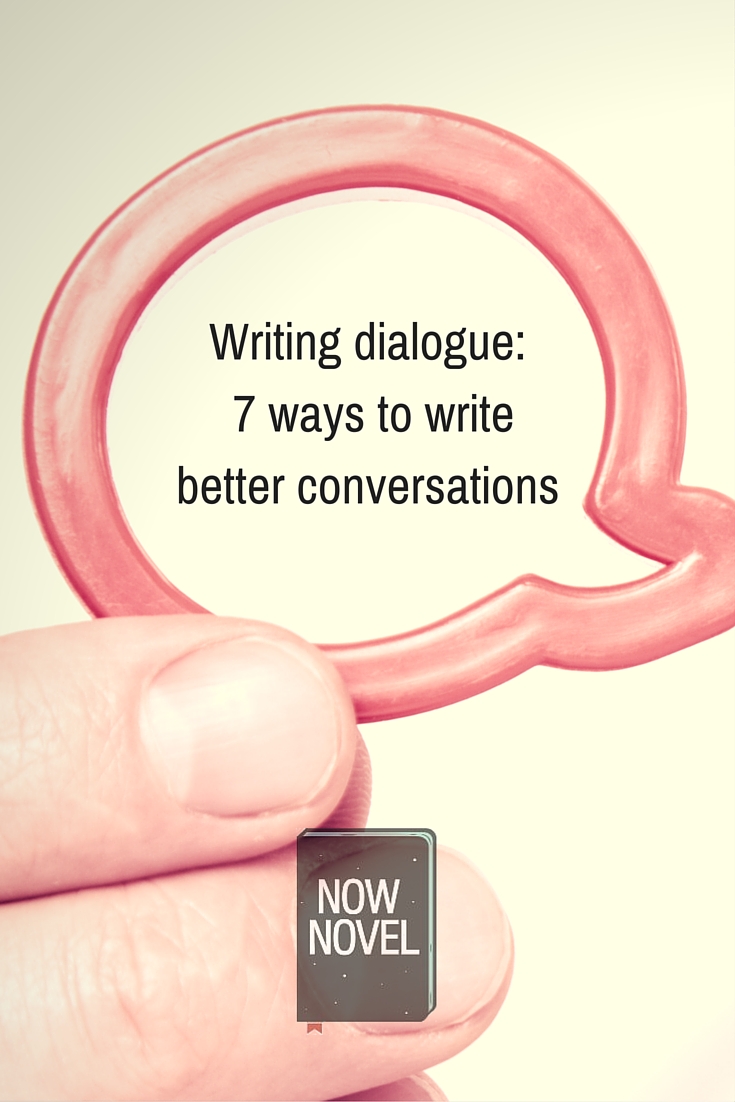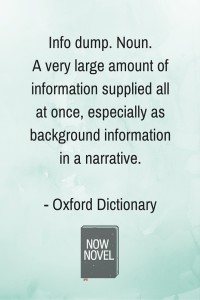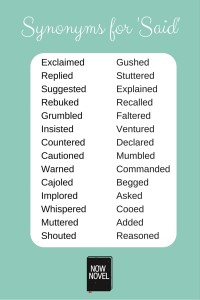Writing dialogue presents a unique set of challenges. A single italicized word can change the whole tone and meaning of an exchange, for example. Compare a person telling a questioner ‘that’s all I can remember’ with ‘that’s all I can remember.’ The difference in emphasis alters the meaning of the sentence. Here are 7 ways to write better dialogue:
1: Stop using dialogue for information dumps
The Oxford Dictionary defines an info dump as ‘a very large amount of information supplied all at once, especially as background information in a narrative.’ Telling factual information in this way can bore the reader at best. At worst, when used in dialogue, it can make your characters read as wooden, authorial devices. Avoid attempting to cram each character’s backstory into your dialogue. Using dialogue to refresh readers’ memories about prior events in your story can be risky since the device itself might be too transparent. Some common abuses of dialogue for info dumps include:
- Speech that starts ‘As you know, [character name]’. If the other character knows the information already, would their interlocutor be likely to repeat the entire story?
- Speech that gives far more than the essential information – real people condense a lot and omit unnecessary information.
Part of the cause of the second problem is that novice writers are often hyper-aware of the reader as an implied eavesdropper on characters’ conversation. This causes writers to include too much in conversation between characters that is intended for the reader’s benefit. Janice Hardy uses this idea to suggest how to tell if you’re info-dumping in dialogue or not. When characters share information, says Janice, ‘If the information is for the reader’s benefit, chances are you’re dumping. If the information is for the character’s benefit (or detriment), chances are it’s fine.’
2: Keep the conversation moving at a cracking pace
If characters talk on and on without a pause or their conversation partners chiming in, it can feel boring and stilted. You may of course want to write a character who tends to drone as either a source of comic relief or simply to show something about the character in question. In real life, however, people often interrupt each other, or don’t finish their sentences. For example:
‘I thought you were going to fetch my -‘
‘They were closed, one of us can go tomorrow’.
It’s fine and natural for characters to speak at length from time to time. If a character does need to talk for a page, make sure that what they were saying is vital to the story in some way. If a character is narrating a particularly traumatic event or something that is crucial to your themes, a long monologue might feel apt. Remember to at least vary the length of sentences as people usually do.
Creating rhythmic interest will help to maintain the reader’s attention.
3: Don’t make dialogue too lifelike
This advice might seem counter-intuitive – after all, shouldn’t dialogue feel like real speech? The answer is ‘yes’, but dialogue can feel lifelike without including all the clutter and repetition that can make the written word sound clunky. An analogy: In stage acting, actors have to project their voices and expressions so that the person in the back row can feel the emotion and understand the meaning and implications of each piece of dialogue or event. In film, because the action is so up close, the smallest emphasis can say a lot more. Dialogue on the page is like the magnified screen compared to to the stage of actual, real-world speech. Each detail stands out more. We don’t always notice people’s more monotonous, repetitive word use, but in text each word stands out. For this reason, make sure that you don’t put in every unnecessary detail of a conversation when writing dialogue so that you can avoid it dragging too much.
4: Write dialogue that establishes your desired mood
Many aspiring authors make the mistake of writing dialogue that is at odds with the intended mood of a scene in the story.
Think about how the immediate environs and the level of tension in a scene might affect or change how characters speak. A character whose voice usually booms would probably whisper if there were other characters around who should not overhear sensitive information.
Hushed conversation, as an example, will involve characters trying to say as much using as few words as possible. They might break off mid-sentence more frequently to avoid being overheard. In a tense, high-drama scene, a long monologue might feel out-of-place, but more importantly it could also destroy the tension you have carefully built in the preceding narrative.
The following preview from our monthly writing webinars shares several things dialogue should not be:
5: Think about ‘text’ versus ‘subtext’
It’s not only how your characters speak but also what they say that is important. Chuck Wendig of Terrible Minds reminds aspiring writers (Chuck’s creative use of curse words is NSFW) that writing great dialogue is as much about what is not said and what is implied as it is about the words on the page. Says Chuck, ‘Meaning exists beneath what’s said. The best real world example of this is the dreaded phrase spoken by men and women the world around: “I’m fine.” Said with jaw tight. Said with averted eyes. Said in sharp, clipped tongue.’
Text is the flow of actual words that makes up your characters’ conversation. Subtext is ‘an underlying and often distinct theme in a piece of writing or conversation’ (OED). Make sure that what your characters say creates interest and furthers your themes by implying that there is more to be said. As an example, what might the subtext be if a character pretends to not care about having been jilted at the alter (as Aunt Dodie does in Alice Munro’s short story The Ottawa Valley)? It could be pride, or the subtext could use what is not said to show how lonely and embarrassing the experience was for the character. The mother of the narrator in The Ottawa Valley says (once Dodie is out of earshot) that she used to hear Aunt Dodie cry every night. The way characters contradict each other, either directly or when giving contrary views to other characters, can create all kinds of fascinating subtext that provides character depth.
Subtext can help you to reveal both the internal and external world of your characters – the stories they tell themselves and the stories they tell others.
6: Let each character’s speech be their signature
Another mistake widespread among aspiring writers is making character dialogue too samey. Unless your characters inhabit a fictional world consisting entirely of clones, each character’s speech should be a unique identifier that gives your novel the richness of an ensemble cast where no part is too small to be worth playing. Charles Dickens is one of the great masters of this. Through dialogue, the words that characters repeatedly use, the level of characters’ language ability and more, Dickens is able to say a lot about his characters. He also uses characters’ verbal tics to humorous effect in books such as Nicholas Nickleby and Great Expectations.
7: He said, she said: Character identifiers in dialogue
One of the elements of dialogue in fiction that many writers find tricky is character identifiers – words such as ‘he said’ and ‘she said’. In everyday speech, we are able to look at who is speaking and/or hear through people’s distinct vocal qualities who is doing the talking. Writing doesn’t give us these visual and auditory cues automatically, so they have to be built into your dialogue. There are two common mistakes novice writers make with identifiers:
- Overusing ‘said’
- Using replacements for ‘said’ that seem bizarre
Much of the time, the meaning and implications of what a character says do enough to tell the reader the tone of a character’s voice and their emotional state. For example, ‘You forgot to do the dishes again’ naturally sounds scolding and perhaps irritable. Although you could have ‘ ‘You forgot to do the dishes again,’ she grumbled, ‘said’ in this case is fine. Continuous use of ‘said’ can grow monotonous, however. Also remember that different genres have different norms regarding this. It is far more common in fantasy fiction to come across synonyms for said that are dramatically expressive (such as ‘barked’, ‘threatened’, ‘chuckled’ and so forth).
Using character identifiers when writing dialogue helps guide readers to see who is speaking, but make sure you don’t use said synonyms that perplex readers. For example, would a real person ‘squeak’ or ‘chirp’ a line of dialogue? Make sure that the reader can imagine a real person saying something in the manner you describe. A good solution is to read all your dialogue out loud.
Before you begin writing dialogue, you need to outline your characters. Start the Now Novel process and create your novel’s cast.




6 replies on “Writing dialogue: 7 ways to write better conversations”
I also find it very odd when writers use dialogue between peers to describe the details of a procedure to the audience, when the peers would use jargon and understand each other without sharing details.
Yes, it is quite distracting. It’s a tricky line when writing in a genre such as crime police procedurals that go into scientific subjects such as forensics. Including any technical details should always be done with a light touch, to avoid overwhelming the story with authenticating detail.
I completely agree with this post. I would only add some technicalities that could make it or break it. Such as using correct dialogue tags, adjectives after those tags… Something like this https://katherinemilkovich.wordpress.com/2016/08/16/writing-style-and-dialogue/
Because unfortunately, I saw a lot of people ruining perfectly good dialogues by not following those simple writing rules.
Thanks for weighing in, Katarina. You’re right – it’s important to know when to use dialogue tags or rather show who is speaking to whom via body language and the content of what characters say.
Thanks, Bridget for your helpful post. Quite exhaustive as usual. The point “Let each character’s speech be their signature” is just the aspect I’m struggling with in my WIP. I appreciate that every character should have his own unique voice but how to achieve this is the issue.
Thank you Ohita, this comment slipped past. A unique voice can be something as small as a the type of body language a character uses while speaking (such as folding their arms or other defensive-appearing gestures). The flipside of this is that if you work too hard to make each character’s voice unique, characters could start becoming almost like caricatures. A few small details often do the trick.